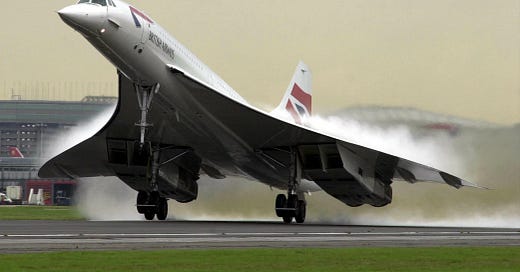The Concorde Fallacy & Kenny Rogers
Economists call this the sunk cost fallacy — the human tendency to keep investing in something simply because we’ve already invested so much.
The Concorde Fallacy
In the 1960s, two of the world’s great powers — Britain and France — got together to build something that felt like the future.
The Concorde.
A supersonic passenger jet that could fly from New York to London in under 3.5 hours.
Twice the speed of sound.
Faster than anything commercially flown before or since.
It was sleek. Iconic. Visionary.
And, economically speaking, an absolute disaster.
How It Happened
The original cost projections were ambitious but manageable: about $70 million.
But the deeper they got, the more complicated it became.
Engineering challenges.
Safety concerns.
Fuel costs.
Political negotiations.
All of it piled up.
By the time it was done, the cost had ballooned to more than $1.3 billion.
In today’s dollars? Roughly $12–15 billion.
Only 20 Concordes were ever built.
It never became commercially viable.
It lost money every year it operated.
But even when it was obvious that the program was doomed, Britain and France kept pouring more money into it.
Why?
Because they had already poured so much money into it.
The Sunk Cost Fallacy
Economists call this the sunk cost fallacy — the human tendency to keep investing in something simply because we’ve already invested so much.
We think:
"I’ve already put too much into this to quit now."
Even if quitting would actually be the smartest thing to do.
It Shows Up Everywhere
This isn't just about supersonic airplanes.
The U.S. kept escalating Vietnam, even when victory was no longer realistic.
Blockbuster clung to physical stores long after streaming had already changed the game.
And gamblers keep playing — not because they believe they’ll win, but because they’ve already lost too much to quit.
Where It Gets Personal
You don’t have to be running a government or sitting at a blackjack table to get trapped by sunk costs.
The older we get, the more vulnerable we are to it.
You build a career. A reputation. A life.
You invest years — sometimes decades — into a role, a company, a cause, a business, a relationship, a community.
And even when something inside you starts whispering that it may be time for change — you stay.
You double down.
Not because you love it.
But because you’ve already given so much to it.
The Concorde Question
At some point in the second half of life, it’s worth asking:
Am I trapped in my own Concorde Fallacy?
Am I still pouring time, energy, money, and years into something that no longer fits — simply because I’ve already invested so much?
Is there something new I’m being invited to focus on?
What Happened After the Concorde?
The Concorde officially retired in 2003.
But the technology, the research, and the ambition that went into it didn’t go to waste:
Its work on aerodynamics advanced future aircraft designs.
Its fly-by-wire systems laid the groundwork for modern flight control.
Its safety challenges pushed the entire industry to improve long-term passenger safety.
And the international partnership behind it helped lead to the rise of Airbus as a major global manufacturer.
The Concorde didn’t give us faster planes.
It gave us safer, more efficient, and more sustainable air travel.
It helped focus the future on what actually mattered.
The Second Calling
The same is true for us.
Letting go of something that no longer serves you doesn’t mean it was a waste.
You carry it forward.
The skills.
The experience.
The wisdom.
The lessons.
Even what didn’t “work” shapes who you are for what comes next.
Or, to borrow from one of the most famous gamblers of all:
"You’ve got to know when to hold ‘em, know when to fold ‘em, know when to walk away, and know when to run."
And that’s where some of us are.
We know it’s time to walk away — but we ante up for the next hand over and over again.
P.S.
If you’re in that space right now — where you’re starting to sense something new calling but aren’t sure what it is — I offer a 1:1 coaching subscription for $129. You get access to my CFA workbook and a Zoom session to help you name what’s next. You can upgrade anytime if you're ready.
"And somewhere in the darkness, the gambler he broke even."





A fine parable, well told. The robes in this monastery are stitched with many a sunk cost, friend. And the hardest practice is not meditation, not chanting, but knowing when to set the damn thing down and walk on.
Sometimes wisdom sounds suspiciously like Kenny Rogers. And sometimes, the holiest act is folding with grace.
Virgin Monk Boy